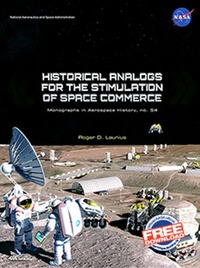Review: Historical Analogs for the Stimulation of Space Commerceby Jeff Foust
|
| Launius examines six cases of public-private partnerships from elsewhere in American history and the lessons they may provide to future such partnerships in space. |
While those efforts may be novel in the space arena, public-private partnerships are hardly new in general. As space historian Roger Launius notes in the introduction of Historical Analogs for the Stimulation of Space Commerce, a monograph recently published by NASA and freely available as an ebook, such partnerships have been used in any number of forms throughout American history. Only now, thanks to the growth of capabilities in the private sector, coupled with government seeking cost savings, have public-private partnerships found a role in spaceflight.
After a “breathless” review of spaceflight history and commercial uses of space, and an acknowledgement of the “use and abuse” of historical analogies, Launius then examines six cases of public-private partnerships from elsewhere in American history and the lessons they may provide to future such partnerships in space. Those range from relatively well-known examples, like the construction of transcontinental railroads in the 19th century, to lesser-known cases like support of Antarctic exploration and collaboration between the government and companies in supporting national parks.
Of the six case studies, the two that Launius deems most relevant to spaceflight are the two transportation ones: railroads and government support of aviation in the 20th century, which he believes offer many lessons for the development of new space transportation systems. “The similarities include the high startup costs associated with new, more-efficient launchers; the highly regulated operational environment; and the high risk/high return potential of the endeavor,” he writes when comparing launch systems with the development of railroads.
Some of the measures taken in support of railroads and aviation aren’t, of course, directly applicable to spaceflight: the lucrative land grants the government provided to railroad developers won’t work in spaceflight, particularly under current treaties. Others, though, make as much since in 21st century as they did in the 19th and 20th, he argues, like contracts for services, direct and indirect financial support for companies developing those services, and government funding of research and development that can be transferred to the private sector.
| “NASA must now develop more equal partnerships to accomplish its space exploration mandate,” he writes. “This shift will be difficult, but it is critical for a robust future.” |
It’s clear from this monograph that Launius believes the future of human spaceflight is in the hands of commercial entities, supported at least in part with public-private partnerships. With constrained budgets for traditional government programs, and little public interest in increasing such spending, “any expansive space program in the 21st century will require a practical, cost-effective, commercial basis,” he concludes. “Leveraging a declining public investment for this agenda with public-private partnerships on a more equitable basis is the most obvious methodology for achieving an expansive future in space.”
Achieving that, he acknowledges in the book’s conclusion, will not be easy, in large part because it means undoing decades of business-as-usual at NASA. “NASA must now develop more equal partnerships to accomplish its space exploration mandate,” he writes. “This shift will be difficult, but it is critical for a robust future.” Historical Analogs for the Stimulation of Space Commerce offers a guide for how that future could be achieved, based on the lessons of the past.
